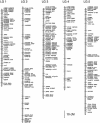Genetic linkage mapping of zebrafish genes and ESTs
- PMID: 10779498
- PMCID: PMC310859
- DOI: 10.1101/gr.10.4.558
Genetic linkage mapping of zebrafish genes and ESTs
Abstract
Genetic screens in zebrafish (Danio rerio) have isolated mutations in hundreds of genes essential for vertebrate development, physiology, and behavior. We have constructed a genetic linkage map that will facilitate the identification of candidate genes for these mutations and allow comparisons among the genomes of zebrafish and other vertebrates. On this map, we have localized 771 zebrafish genes and expressed sequence tags (ESTs) by scoring single-stranded conformational polymorphisms (SSCPs) in a meiotic mapping panel. Of these sequences, 642 represent previously unmapped genes and ESTs. The mapping panel was comprised of 42 homozygous diploid individuals produced by heat shock treatment of haploid embryos at the one-cell stage (HS diploids). This "doubled haploid" strategy combines the advantages of mapping in haploid and standard diploid systems, because heat shock diploid individuals have only one allele at each locus and can survive to adulthood, enabling a relatively large quantity of genomic DNA to be prepared from each individual in the mapping panel. To integrate this map with others, we also scored 593 previously mapped simple-sequence length polymorphisms (SSLPs) in the mapping panel. This map will accelerate the molecular analysis of zebrafish mutations and facilitate comparative analysis of vertebrate genomes.
Figures







Similar articles
-
A comparative map of the zebrafish genome.Genome Res. 2000 Dec;10(12):1903-14. doi: 10.1101/gr.10.12.1903. Genome Res. 2000. PMID: 11116086 Free PMC article.
-
A genetic linkage map for zebrafish: comparative analysis and localization of genes and expressed sequences.Genome Res. 1999 Apr;9(4):334-47. Genome Res. 1999. PMID: 10207156
-
Rapid mapping of zebrafish mutations with SNPs and oligonucleotide microarrays.Genome Res. 2002 Dec;12(12):1929-34. doi: 10.1101/gr.777302. Genome Res. 2002. PMID: 12466297 Free PMC article.
-
Perspectives for identification of mutations in the zebrafish: making use of next-generation sequencing technologies for forward genetic approaches.Methods. 2013 Aug 15;62(3):185-96. doi: 10.1016/j.ymeth.2013.05.015. Epub 2013 Jun 5. Methods. 2013. PMID: 23748111 Review.
-
Zebrafish genomics: from mutants to genes.Trends Genet. 1997 May;13(5):183-90. doi: 10.1016/s0168-9525(97)01129-3. Trends Genet. 1997. PMID: 9154001 Review.
Cited by
-
AFLP-based genetic linkage maps of the pacific oyster Crassostrea gigas Thunberg.Mar Biotechnol (NY). 2004 Jan-Feb;6(1):26-36. doi: 10.1007/s10126-003-0001-0. Epub 2003 Oct 20. Mar Biotechnol (NY). 2004. PMID: 14564534
-
Sex-specific recombination rates in zebrafish (Danio rerio).Genetics. 2002 Feb;160(2):649-57. doi: 10.1093/genetics/160.2.649. Genetics. 2002. PMID: 11861568 Free PMC article.
-
A microsatellite linkage map of Barramundi, Lates calcarifer.Genetics. 2007 Feb;175(2):907-15. doi: 10.1534/genetics.106.059972. Epub 2006 Dec 18. Genetics. 2007. PMID: 17179079 Free PMC article.
-
spiel ohne grenzen/pou2 is required during establishment of the zebrafish midbrain-hindbrain boundary organizer.Development. 2001 Nov;128(21):4165-76. doi: 10.1242/dev.128.21.4165. Development. 2001. PMID: 11684654 Free PMC article.
-
Global analysis of hematopoietic and vascular endothelial gene expression by tissue specific microarray profiling in zebrafish.Dev Biol. 2006 Nov 15;299(2):551-62. doi: 10.1016/j.ydbio.2006.08.020. Epub 2006 Aug 10. Dev Biol. 2006. PMID: 16999953 Free PMC article.
References
-
- Driever W, Solnica-Krezel L, Schier AF, Neuhauss SCF, Malicki J, Stemple DL, Stainier DYR, Zwartkruis F, Abdelilah S, Rangini Z, et al. A genetic screen for mutations affecting embryogenesis in zebrafish. Development. 1996;123:37–46. - PubMed
-
- Gates MA, Kim L, Egan ES, Cardozo T, Sirotkin HI, Dougan ST, Laskari D, Abagyan R, Schier AF, Talbot WS. A genetic linkage map for zebrafish: Comparative analysis of genes and expressed sequences. Genome Res. 1999;9:334–347. - PubMed
-
- Geisler R, Rauch G-J, Baier H, van Bebber F, Bross L, Dekens MPS, Finger K, Fricke C, Gates MA, Geiger H, et al. A radiation hybrid map of the zebrafish genome. Nat Genet. 1999;23:86–89. - PubMed
-
- Haffter P, Granato M, Brand M, Mullins MC, Hammerschmidt M, Kane DA, Odenthal J, van Eeden FJM, Jiang Y-J, Heisenberg C-P, et al. The identification of genes with unique and essential functions in the development of the zebrafish, Danio rerio. Development. 1996;123:1–36. - PubMed
Publication types
MeSH terms
Substances
Grants and funding
LinkOut - more resources
Full Text Sources
Other Literature Sources
Molecular Biology Databases
